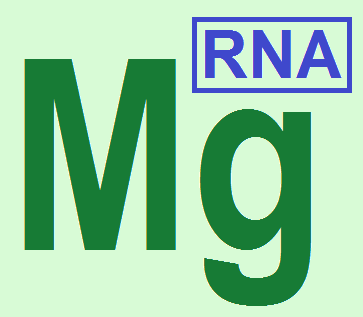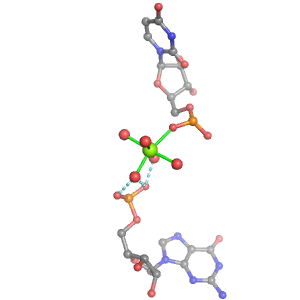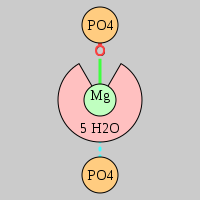| Mg2+ ion |
Site type |
Inner-sphere ligands |
Outer-sphere ligands |
|---|
| PDB ID |
Mg2+ ID |
Oph |
Or |
Ob+Nb |
Water |
Other |
Pout |
Rout |
Bout |
|
3i1z |
A1569 |
Oph·Pout |
U:A1095(OP2) |
|
|
A1741, A1742, A1743, A1744 |
|
C:A1096 |
G:A1094 |
C:A1109, G:A1108 |
|
2qoy |
A1569 |
Oph·Pout |
A:A768(OP2) |
|
|
A2031, A2032, A2033, A2034, A2035 |
|
U:A804 |
|
G:A769 |
|
2qp0 |
A1569 |
Oph·Pout |
A:A608(OP2) |
|
|
A2017, A2018, A2019, A2020, A2021 |
|
A:A607 |
G:A292 |
A:A630, A:A609, C:A631, U:A610 |
|
2i2p |
A1570 |
Oph·Pout |
A:A572(OP1) |
|
|
A1741, A1742, A1743, A1744, A1745 |
|
A:A573 |
|
A:A819 |
|
3ofo |
A1570 |
Oph·Pout |
G:A100(OP2) |
|
|
A1750, A1751, A1752, A1753, A1754 |
|
A:A101 |
|
G:A64, G:A100, A:A101, G:A102 |
|
2qoy |
A1570 |
Oph·Pout |
A:A572(OP1) |
|
|
A2036, A2037, A2038, A2039, A2040 |
|
G:A917 |
|
A:A819 |
|
2qbh |
A1570 |
Oph·Pout |
A:A572(OP1) |
|
|
A1736, A1737, A1738, A1739, A1740 |
|
A:A573 |
|
A:A819 |
|
3ofa |
A1571 |
Oph·Pout |
G:A100(OP2) |
|
|
A1754, A1755, A1756, A1757, A1758 |
|
A:A101 |
|
G:A64, G:A100, A:A101 |
|
3ofp |
A1571 |
Oph·Pout |
G:A100(OP2) |
|
|
A1747, A1748, A1749, A1750, A1751 |
|
A:A101 |
|
G:A64, A:A101 |
|
3ofx |
A1571 |
Oph·Pout |
G:A100(OP2) |
|
|
A1754, A1755, A1756, A1757, A1758 |
|
A:A101 |
|
G:A64, G:A100, A:A101 |
|
2qoy |
A1571 |
Oph·Pout |
G:A21(OP1) |
|
|
A2041, A2042, A2043, A2044, A2045 |
|
U:A561 |
G:A568, G:A567 |
A:A573, G:A567 |
|
2z4k |
A1571 |
Oph·Pout |
A:A572(OP1) |
|
|
A1741, A1742, A1743, A1744, A1745 |
|
A:A573 |
|
A:A819 |
|
3i1q |
A1572 |
Oph·Pout |
G:A100(OP2) |
|
|
A1750, A1751, A1752, A1753, A1754 |
|
A:A101 |
|
G:A64, G:A100, A:A101 |
|
3i21 |
A1572 |
Oph·Pout |
C:A352(OP2) |
|
|
A1771, A1772, A1773, A1774, A1775 |
|
G:A354 |
C:A330, C:A352 |
C:A330, G:A354, A:A59 |
|
3i1s |
A1572 |
Oph·Pout |
C:A352(OP2) |
|
|
A1769, A1770, A1771, A1772, A1773 |
|
G:A354 |
C:A352 |
G:A354, A:A59, C:A330 |
|
3i1o |
A1572 |
Oph·Pout |
C:A352(OP2) |
|
|
A1769, A1770, A1771, A1772, A1773 |
|
G:A354 |
C:A352 |
C:A330, G:A354, A:A59 |
|
3i1m |
A1572 |
Oph·Pout |
G:A100(OP2) |
|
|
A1755, A1756, A1757, A1758, A1759 |
|
A:A101 |
|
G:A64, G:A100, A:A101 |
|
3oaq |
A1572 |
Oph·Pout |
G:A100(OP2) |
|
|
A1755, A1756, A1757, A1758, A1759 |
|
A:A101 |
|
G:A64, G:A100, A:A101 |
|
3or9 |
A1572 |
Oph·Pout |
G:A100(OP2) |
|
|
A1754, A1755, A1756, A1757, A1758 |
|
A:A101 |
|
G:A64, G:A100, A:A101 |
|
3i1z |
A1572 |
Oph·Pout |
G:A100(OP2) |
|
|
A1753, A1754, A1755, A1756, A1757 |
|
A:A101 |
|
G:A64, G:A100, A:A101 |
|
2qbf |
A1573 |
Oph·Pout |
A:A572(OP1) |
|
|
A1763, A1764, A1765, A1766, A1767 |
|
A:A573 |
|
A:A819 |
|
2i2u |
A1573 |
Oph·Pout |
C:A352(OP2) |
|
|
A1740, A1741, A1742, A1743, A1744 |
|
G:A354 |
C:A330, C:A352, G:A331 |
C:A330, G:A354, A:A59 |
|
2qp0 |
A1573 |
Oph·Pout |
G:A100(OP2) |
|
|
A2037, A2038, A2039, A2040, A2041 |
|
A:A101 |
|
G:A64, G:A100, A:A101 |
|
2qow |
A1573 |
Oph·Pout |
G:A100(OP2) |
|
|
A2034, A2035, A2036, A2037, A2038 |
|
A:A101 |
|
G:A64, A:A101 |
|
2qbj |
A1573 |
Oph·Pout |
A:A572(OP1) |
|
|
A1761, A1762, A1763, A1764, A1765 |
|
A:A573 |
|
A:A819 |
|




